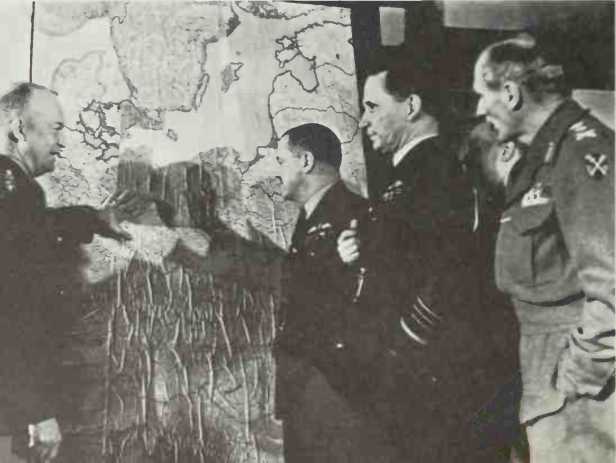Below: Planning Operation Overlord left to right: Eisenhower, Air Chief-Marshal Leigh-Mallory,
Air Chief-Marshal Tedder and Montgomery.
Opposite top: A German Kampfgruppe marching to take up their positions along the Atlantic Wall.
Opposite center: .American Flying Fortresses, newly arrived in Britain, soon to be used against the factories of the Ruhr. Opposite bottom: •American airmen shortly before D-Day.

In January 1944 General Dwight D. Eisenhower returned to London to take charge of the mightiest fighting force in Western history. The directive from the Allied Combined Chiefs of Staff was simple. The principal paragraph read, ‘You will enter the continent of Europe and, in conjunction with the other Allied Nations, undertake operations aimed at the heart of Germany and the destruction of her Armed Forces.’ The destruction of the German forces was the paramount principle; the occupation of land was important only in so far as it would help to achieve this goal.
Even before the United States entered the war American planners had concluded that, in the event of war with the Axis powers, Germany would have to be defeated first. Not only was she industrially far more powerful than Japan, but the Allies would find it easier to mass forces for a concentrated attack against her. Any offensive mounted against the Japanese would have to be conducted almost solely by the United States.
The ‘Japan First’ viewpoint, however, was not without its advocates and, especially after the attack on Pearl Harbor on 7 December 1941, found increasingly vocal support. But the black days immediately after the attack found Allied forces reeling backward, trying desperately to slow the Japanese advance. Meanwhile, the Germans had been stopped short of Moscow and, with the winter of 1942 setting in, Russian partisans were strangling German communications and supply lines. Thus while in the Pacific Allied forces were steadily being driven out of Asia, in the West the Germans appeared to be an easier target, wedged in between British and Russian threats.
Keeping Russia in the war was imperative, but it was necessary to assure her that, contrary to appearances in those last days of 1941, she was not carrying on the war with Germany alone. To the Russians, anything other than a direct attack on Germany would be unpalatable, but especially a front in the Pacific where the Soviet Union was not even a belligerent. Thus from 1941 to 1943, the goal of defeating Germany first became more urgent.
Although British and American planners were in agreement over the need to defeat Germany before Japan, they could not decide where and when the offensive should take place. As early as 1942 General George C. Marshall had planned a cross-channel invasion (code name ‘Roundup') but the British had balked. In 1942 the British would have had to bear the brunt of the responsibility and provide most of the manpower, which they could not afford to do at a time when their forces were hard-pressed in North Africa.
The Russians, desperately holding off the Germans, were not favorably impressed with Allied gains in the Mediterranean, for they failed to see how it would materially relieve the pressure on their front. Winston Churchill, however, continued to advocate the ‘soft underbelly’ of Europe approach, arguing that these operations would knock Italy out of the war and stop the attacks upon British convoys that were trying to continue the lifeline through the Mediterranean to the Suez Canal. Control of the Italian bases would undermine if not completely remove the Luftwaffe as a threat to Allied shipping in the Mediterranean, and German forces might have to be diverted from other fronts to replace the Italian troops that would be lost.
American thinkers, however, felt that the application of Allied resources to what was essentially a side show would mean diverting badly needed and meager supplies to a painfully slow, grinding war that would not yield immediate dividends either in the early defeat of Germany or the relief of the Russian front. As a compromise, the invasion of Sicily and the subsequent Italian campaign were launched.
The slow but steady progress in Italy permitted the Combined Chiefs of Staff to turn once again to the planning of a cross-channel invasion. Such an operation had in the meantime attained a new sense of urgency. The Russians had smashed the Germans at Stalingrad and were on the odensiN e for the first time. Their demands for a coordinated attack on two fronts would not be satisfied by the diversionary Italian front.
On the German side, since the failure to capture. Moscow in the fall of 1941, the unpleasant prospect of having to fight a two-front war had become a reality by 1942, first with the. Mlied.orth African invasion and then with the Italian campaign. Allied progress in Italy pointed out their vulnerability in the West and now, for the first time since Dunkirk, .Adolf Hitler set about defending that flank.
The task of defending land which had already been conquered in the West appeared to be far more difficult than the original blitzkrieg. Since the in asion coastline, which stretched in a might) arc from Norway to Greece, had been penetrated by the Allies in Italy, Allied superiority in air and nas al forces could assure a safe co cr for landings anywhere. The coasts of Denmark and Norway appeared especially vulnerable; landings via the North Sea south into Germany was also a possibility. .s a matter of fact, German intelligence agents flooded higher headquarters with reports of prospective landings in the vicinity of the Franco-Spanish border as well as in southern France.
Logic, however, dictated that a direct invasion across the English Channel could be best supported from England and this possibility came to receive the most urgent attention in Germany. The strengthening of fixed fortifications along the Channel coast and the reinforcing of the garrisons manning these structures claimed the highest priorit) ; responsibility for the project was given to Field. Marshal on Runstedt.




 World History
World History









